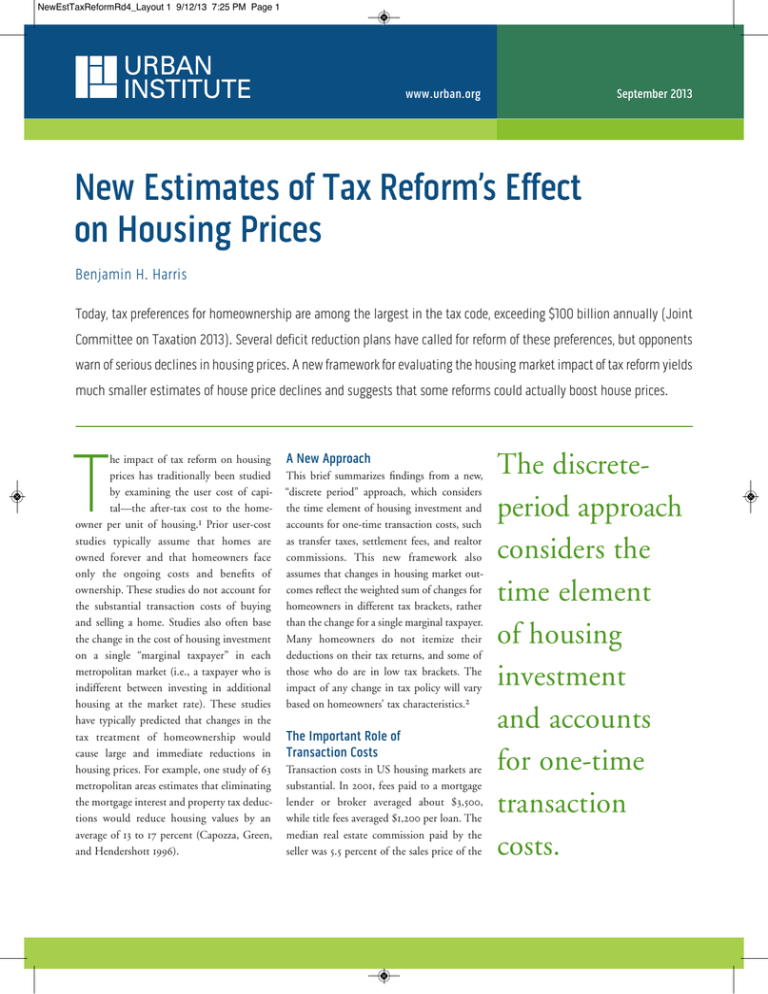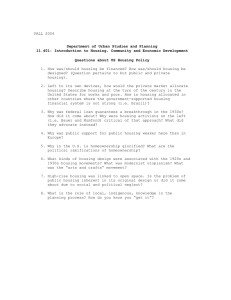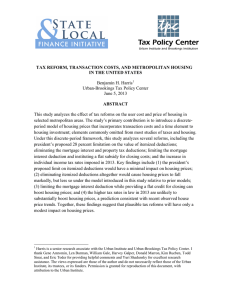New Estimates of Tax Reform’s Effect on Housing Prices
advertisement

NewEstTaxReformRd4_Layout 1 9/12/13 7:25 PM Page 1 September 2013 www.urban.org New Estimates of Tax Reform’s Effect on Housing Prices Benjamin H. Harris Today, tax preferences for homeownership are among the largest in the tax code, exceeding $100 billion annually (Joint Committee on Taxation 2013). Several deficit reduction plans have called for reform of these preferences, but opponents warn of serious declines in housing prices. A new framework for evaluating the housing market impact of tax reform yields much smaller estimates of house price declines and suggests that some reforms could actually boost house prices. T he impact of tax reform on housing prices has traditionally been studied by examining the user cost of capital—the after-tax cost to the homeowner per unit of housing.1 Prior user-cost studies typically assume that homes are owned forever and that homeowners face only the ongoing costs and benefits of ownership. These studies do not account for the substantial transaction costs of buying and selling a home. Studies also often base the change in the cost of housing investment on a single “marginal taxpayer” in each metropolitan market (i.e., a taxpayer who is indifferent between investing in additional housing at the market rate). These studies have typically predicted that changes in the tax treatment of homeownership would cause large and immediate reductions in housing prices. For example, one study of 63 metropolitan areas estimates that eliminating the mortgage interest and property tax deductions would reduce housing values by an average of 13 to 17 percent (Capozza, Green, and Hendershott 1996). A New Approach This brief summarizes findings from a new, “discrete period” approach, which considers the time element of housing investment and accounts for one-time transaction costs, such as transfer taxes, settlement fees, and realtor commissions. This new framework also assumes that changes in housing market outcomes reflect the weighted sum of changes for homeowners in different tax brackets, rather than the change for a single marginal taxpayer. Many homeowners do not itemize their deductions on their tax returns, and some of those who do are in low tax brackets. The impact of any change in tax policy will vary based on homeowners’ tax characteristics.2 The Important Role of Transaction Costs Transaction costs in US housing markets are substantial. In 2001, fees paid to a mortgage lender or broker averaged about $3,500, while title fees averaged $1,200 per loan. The median real estate commission paid by the seller was 5.5 percent of the sales price of the The discreteperiod approach considers the time element of housing investment and accounts for one-time transaction costs. NewEstTaxReformRd4_Layout 1 9/12/13 7:25 PM Page 2 New Estimates of Tax Reform’s Effect on Housing Prices house (Woodward 2008). For a sample of 23 cities, the portion of the transaction cost upon purchase is about 1.5 percent of the purchase price, while closing costs amount to about 6.3 percent (5.5 percent from realtor commissions and 0.8 percent from transfer taxes). These costs vary widely by state and municipality. For example, consumers purchasing a home in Chicago are subject to taxes of 0.1 percent levied by the state, 0.05 percent levied by the county, and 1.05 percent levied by the city. In contrast, homebuyers in Dallas, Houston, Kansas City, Portland, and St. Louis pay no transaction taxes. The relative importance of transaction costs depends on the duration of ownership (figure 1). For homes owned three years or less, transaction costs constitute a higher share of total costs than interest, property taxes, or the forgone return to housing equity. For homes owned eight years or less, transaction costs exceed both property taxes and opportunity costs. As the period of ownership increases, the relative importance of transaction costs declines, but these costs still make up over 10 percent of total costs, even for homes owned for more than 20 years. Figure 1. Housing Costs by Duration 80 70 Share of costs (percent) 60 • Capping the value of itemized deductions at 28 percent (the president’s proposal) would have little effect on house prices, in large part because such a small share of mortgage interest—just 7 percent— is paid by taxpayers in the 28 percent and Mortgage interest 40 30 Forgone return to housing equity 20 Property tax 10 0 Transaction costs 1 3 5 7 9 11 13 15 17 19 21 23 25 27 29 Housing duration (years) Source: Harris (2013). of this approach are not evident using traditional estimation approaches. higher tax brackets. Using the discreteperiod model, housing values fall only 0.3 percent with little variation across cities. Impacts of Proposed and Legislated Reforms The discrete-period model produces different estimates of the impacts of tax reform on housing prices than prior approaches (table 1). The differences result from the incorporation of transaction costs and the assumption that taxpayers in all income brackets contribute to house price changes. The following are the tax changes analyzed here: 50 • • • Eliminating the mortgage interest and property tax deductions for housing would have a much bigger effect. The discrete-period model estimates housing price declines averaging 11.8 percent, but this estimate is substantially lower than estimates generated when transaction costs are ignored and when outcomes reflect only the effects for the marginal taxpayer. Limiting the mortgage interest deduction and instituting a 2 percent flat subsidy for closing costs raises house prices—by 3.0 percent on average. The potential benefits Increasing individual income tax rates as scheduled in 2013 under the ACA and ATRA are estimated to minimally increase the value of homeownership deductions and exclusions for some taxpayers, and then raise the price of housing by 0.2 percent.3 Potential of a One-Time Homebuyers’ Credit To date, most proposals for reforming the existing tax preference for housing focus on the ongoing costs of homeownership. An alternative to subsidizing the ongoing costs of homeownership is subsidizing the substantial costs of buying and selling a home. This 2. NewEstTaxReformRd4_Layout 1 9/12/13 7:26 PM Page 3 New Estimates of Tax Reform’s Effect on Housing Prices Table 1. Effects of various Tax Policies on Housing Prices AvERAgE PERCENT CHANgE ACROSS CITIES RANgE ACROSS CITIES President’s 28 percent limit on tax expenditures -0.3 -0.2 to -0.3 Elimination of itemized deductions for housing -11.8 -10.3 to -13.8 3.0 1.5 to 4.6 0.2 0.2 TAx REFORm Limiting mortgage interest deduction to 20 percent and introducing 2 percent closing cost credit Effects of ACA and ATRA Source: Harris (2013). Notes: “Range” refers to the simulated changes in 23 selected metropolitan areas. See Harris (2013) for a complete list of cities. In the first three rows, the baseline is the current (2013) law (ie., tax rates following the imposition of ATRA and ACA). The fourth row assumes 2012 law as the baseline and shows the effect of moving to 2013 laws. strategy was tried during the Great Recession, with the federal government subsidizing the cost of first-time homeownership with an $8,000 credit. If such a one-time subsidy was made permanent and extended to all homebuyers, it could reverse the negative housing price effects of scaling back the mortgage interest deduction.4 This strategy would also subsidize homeownership more directly than the mortgage interest deduction, which indirectly subsidizes homeownership by lowering the cost of borrowing and which may simply increase spending on housing—bigger houses, larger lots, and more amenities—rather than expanding homeownership. What more Can Be Learned? This brief outlines a new approach for estimating the relationship between tax reform and housing prices, but many questions remain that warrant further investigation. Have prior tax reforms led to changes in housing prices? In particular, is there empirical evidence that the income tax cuts initiated in 2001 and 2003 influenced housing price trends? What are the likely economic effects of reforms that subsidize homeownership more directly, rather than focusing on mortgage interest? Alternative subsidies, including a first-time homebuyers’ tax credit, an annual credit for homeownership, and a refundable credit for property taxes, merit further study. Lastly, further research can help explain whether changes in housing supply mitigate the impact of tax changes on housing prices. • 3. NewEstTaxReformRd4_Layout 1 9/12/13 7:26 PM Page 4 New Estimates of Tax Reform’s Effect on Housing Prices Notes 1. The ongoing costs of homeownership include the after-tax costs of mortgage interest and property taxes, the opportunity cost of housing equity, and maintenance, minus expected aftertax appreciation. To understand the opportunity cost of housing equity, consider a homeowner purchasing a $200,000 home with an $180,000 mortgage. If the after-tax return on alternative uses of the $20,000 down payment is 6 percent, then the opportunity cost equals $1,200. 2. This analysis is based on Harris (2013) and makes some of the same limiting assumptions as previous work—notably that the supply of urban housing is perfectly inelastic (i.e., that the aggregate stock of housing does not respond to price changes). There is no consensus on this point. Some research has found that the housing supply is nearly perfectly inelastic (Mayer and Somerville 2000), other research has found wide variation between short- and long-run elasticity (Topel and Rosen 1988), while still other research has found extremely wide variation in the supply elasticity across cities (Green, Malpezzi, and Mayo 2005). Despite the lack of agreement, the owner-occupied stock of housing is likely at least somewhat elastic because rentals can be converted to owner-occupied homes and vice versa. However, it is also likely that any supply response—including conversions and changes in new construction—occurs with a lag. All these factors imply that the results presented can be interpreted as either transitory effects or upper bounds. About the Author Benjamin H. Harris is a senior research associate with the Urban Institute and Urban-Brookings Tax Policy Center. 3. The American Taxpayer Relief Act of 2012 (ATRA) permanently extended lower tax rates for most taxpayers. Because of ATRA, only a small percentage of taxpayers faces substantial increases in marginal tax rates in 2013. ATRA did not extend the lower rates on ordinary income for high-income taxpayers, but it did cap the maximum rate on dividends at 20 percent (dividends were previously taxed at a maximum rate of 15 percent, but were scheduled to be taxed as ordinary income beginning in 2013). The Patient Protection and Affordable Care Act (ACA) imposed a new 3.8 percent surtax on investment income beginning in 2013. 4. The first-time homebuyers tax credit offered a fixed-amount credit ($8,000), while the policy modeled in this paper is a flat-rate credit (2 percent of the home price). Though policies would be equal for a $400,000 home, the fixedamount credit would be more beneficial for purchasers of less expensive homes and less beneficial for purchasers of more expensive homes. Harris, Benjamin H. 2013. “Tax Reform, Transaction Costs, and Metropolitan Housing in the United States.” Washington, DC: The Urban Institute. Joint Committee on Taxation. 2013. “Estimates of Federal Tax Expenditures for Fiscal Years 2012–17.” JCS-1-13. Washington, DC: Government Printing Office. Mayer, Christopher J., and C. Tsuriel Somerville. 2000. “Residential Construction: Using the Urban Growth Model to Estimate Housing Supply.” Journal of Urban Economics 48(1): 85–109. Topel, Robert, and Sherwin Rosen. 1988. “Housing Investment in the United States.” Journal of Political Economy 96(4): 718–40. Woodward, Susan E. 2008. “A Study of Closing Costs for FHA Mortgages.” Washington, DC: US Department of Housing and Urban Development, Office of Policy Development and Research. References Capozza, Dennis R., Richard K. Green, and Patric H. Hendershott. 1996. “Taxes, Mortgage Borrowing, and Residential Land Prices.” In Economic Effects of Fundamental Tax Reform, edited by Henry A. Aaron and William G. Gale (171–98). Washington, DC: Brookings Institution Press. Green, Richard K., Stephen Malpezzi, and Stephen K. Mayo. 2005. “Metropolitan-Specific Estimates of the Price Elasticity of Supply of Housing, and Their Sources.” American Economic Review 95(2): 334–39. Copyright © September 2013 The views expressed are those of the author and should not be attributed to the Urban Institute, its trustees, or its funders. Permission is granted for reproduction of this file, with attribution to the Urban Institute. This research was supported by a generous grant from the John D. and Catherine T. MacArthur Foundation and an anonymous funder. URBAN INSTITUTE 2100 m Street, NW ● Washington, DC 20037-1231 (202) 833-7200 publicaffairs@urban.org ● www.urban.org 4.


